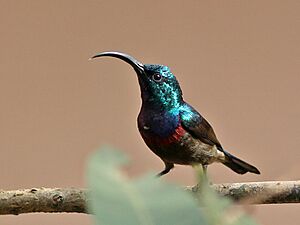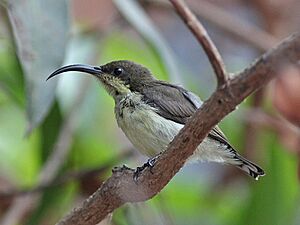Loten's sunbird facts for kids
Quick facts for kids Loten's sunbird |
|
|---|---|
 |
|
| Male with maroon breast band visible | |
 |
|
| Female | |
| Conservation status | |
| Scientific classification | |
| Genus: |
Cinnyris
|
| Species: |
lotenius
|
| Synonyms | |
|
|
The Loten's sunbird (Cinnyris lotenius) is also known as the long-billed sunbird or maroon-breasted sunbird. This small, colorful bird is found only in parts of India and Sri Lanka. It was named after Joan Gideon Loten, who was a Dutch governor in old Ceylon (now Sri Lanka).
Loten's sunbirds look a lot like the purple sunbird, which lives in the same areas. However, you can tell them apart by their longer beak, a maroon (reddish-brown) band on the male's chest, and brownish wings. Like other sunbirds, they mostly eat nectar from flowers, but they also catch insects. They build unique hanging nests.
Contents
What Does a Loten's Sunbird Look Like?
Loten's sunbirds are small, usually about 12 to 13 centimeters (about 5 inches) long. Their long, curved beak is a key feature that helps tell them apart from other sunbirds. The male Loten's sunbird has a shiny purple body with a grey-brown belly. In good light, you can see a maroon band across his chest.
Males also have special yellow and crimson (deep red) feathers on their chest, called pectoral tufts. They use these colorful feathers when they want to impress a female.
The female Loten's sunbird looks different. She has yellow-grey feathers on her back and yellowish feathers on her belly. She does not have the bright purple colors or the maroon chest band that the male has.
These birds are very active. They often bob their heads while looking for food. Their call is a distinct, buzzy "zwick zwick." The male's song is a long, repeated "wue-wue-wue..." that speeds up at the end. They often sing from the tops of trees or even telephone wires.
Where Do Loten's Sunbirds Live?
Loten's sunbirds are found only in peninsular India and Sri Lanka. They live mainly along the Western Ghats mountains and in the southern parts of India. You can also find them in some scattered areas of central India and the northern Eastern Ghats up to Odisha.
They are common in forests and farmlands. You can even spot them in city gardens. In some cities, like Chennai (formerly Madras), they are more common than other types of sunbirds.
How Do Loten's Sunbirds Behave?
Loten's sunbirds do not migrate; they stay in the same areas all year round. When they feed on nectar, they often hover in front of flowers. This is different from purple sunbirds, which usually prefer to perch next to flowers. Besides nectar, Loten's sunbirds also eat small insects and spiders. They will drink from many different kinds of garden plants and wild shrubs.
Reproduction and Life Cycle
The breeding season for Loten's sunbirds is from November to March in India, and from February to May in Sri Lanka. The female bird builds the nest, though the male might join her. They lay two eggs in a hanging nest built in a tree.
The female bird sits on the eggs for about 15 days until they hatch. The nest is made from spider webs, bits of bark, and even caterpillar droppings. It's shaped like a bag. Both parents help feed the young birds. Sometimes, a pair might use the same nest again for a second group of babies.
Interestingly, Loten's sunbirds often build their nests inside the large, messy webs of "social spiders." Inside these big spider webs, the birds create a round chamber. They line it with soft plant material and often make a small "cave" of cobweb over the entrance. If they can't find spider webs, they might build a small, pear-shaped hanging nest, similar to the purple sunbird's nest.
The eggs are usually grayish-white with streak-like spots of greyish-brown. Sometimes, they have hints of green and purple. The spots are often thicker at one end of the egg.
Images for kids




